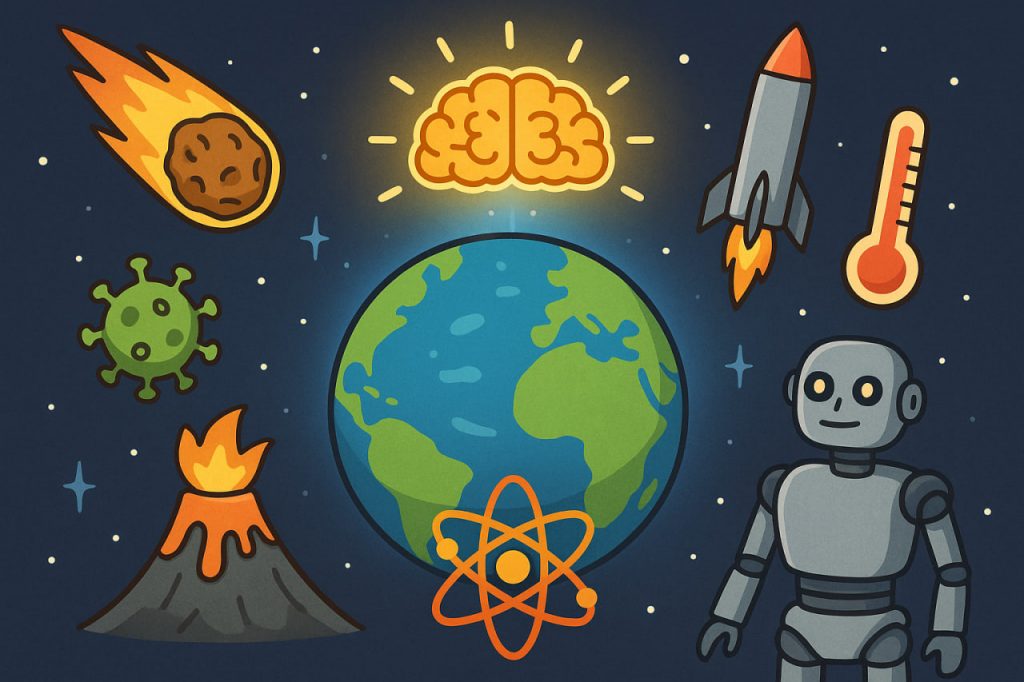The concept of “Doomsday” — the end of the world — has existed for thousands of years in myths and religions. But modern science approaches this question differently. Instead of prophecy, researchers use data, probability, and physical laws to explore the risks that could threaten life on Earth or civilization itself. From cosmic collisions to climate change and artificial intelligence, science seeks not to predict the end, but to understand and prevent it.
The Scientific Meaning of Doomsday
In science, the term “Doomsday” refers to a global catastrophic event — natural or human-made — capable of destroying human civilization or making the planet uninhabitable. Such events are studied within existential risk research, an interdisciplinary field combining physics, biology, and sociology.
Scientists at organizations like Oxford University’s Future of Humanity Institute, NASA, and the Bulletin of the Atomic Scientists analyze these risks, estimating their likelihood and long-term impact.
1. Astronomical Threats
The universe is a dangerous place, and Earth’s survival depends on fragile cosmic balances.
- Asteroid impacts: Large asteroids have hit Earth before — the one that wiped out the dinosaurs 66 million years ago released energy equal to billions of nuclear bombs. Statistically, such impacts occur every few tens of millions of years, but smaller ones can still cause regional disasters.
- Solar storms: The Sun regularly emits bursts of charged particles. A massive solar flare could disrupt satellites, power grids, and global communications. The last major event, the Carrington Event (1859), caused telegraph fires — and today, such a storm could paralyze modern technology.
- Supernovae and gamma-ray bursts: A nearby stellar explosion could strip away Earth’s ozone layer, exposing life to lethal radiation. Fortunately, no such stars are close enough right now.
2. Geophysical and Climate Threats
Earth itself can unleash forces that reshape life:
- Supervolcanoes: Massive eruptions like Yellowstone or Toba can inject dust and sulfur into the atmosphere, blocking sunlight and triggering a “volcanic winter.” The Toba eruption 74,000 years ago nearly caused human extinction.
- Climate change: Human activity is rapidly warming the planet. Rising temperatures, melting ice, and extreme weather could cause mass migrations, food shortages, and ecosystem collapse within this century.
- Oceanic disruptions: A slowdown in ocean currents could alter weather patterns, leading to droughts or freezing conditions in major regions.
3. Biological and Technological Threats
Human innovation carries both potential and danger.
- Pandemics: Natural or engineered pathogens can spread globally, as seen in recent years. Advances in biotechnology also raise ethical and safety concerns.
- Nuclear war: Even a limited nuclear conflict could trigger a “nuclear winter,” blocking sunlight and collapsing agriculture worldwide.
- Artificial intelligence: Rapid AI development brings unknown risks — from job displacement to potential loss of human control. Researchers are working on “AI alignment” to ensure future systems remain safe.
- Nanotechnology and synthetic biology: Unregulated use of self-replicating systems could cause environmental or biological disasters if mishandled.
4. Cosmic Time and the Far Future
Even if humanity avoids self-destruction, the universe itself has an expiration date.
- In 1 billion years: The Sun will become 10% brighter, evaporating oceans and ending life as we know it.
- In 5 billion years: The Sun will expand into a red giant, engulfing Mercury and Venus — possibly Earth.
- In trillions of years: Stars will burn out, galaxies will fade, and the universe will approach heat death, when all energy is evenly distributed and nothing can happen anymore.
These events are far beyond human timescales, but they remind us of the impermanence of everything — even stars.
Can Science Prevent Doomsday?
Yes — at least some scenarios are preventable.
- Asteroid defense: NASA’s DART mission proved we can alter an asteroid’s orbit.
- Climate mitigation: Renewable energy and reforestation can slow global warming.
- Nuclear de-escalation: International treaties and AI-based monitoring reduce war risks.
- Global cooperation: Shared scientific knowledge can address pandemics and technological ethics.
Science cannot stop the passage of time or the death of stars, but it can buy humanity millions of years of survival — if we act wisely.
Ethical and Philosophical Questions
The study of existential risk also raises profound questions:
- Should humanity attempt to colonize other planets to ensure survival?
- Do we have moral duties to future generations?
- Can technological progress coexist with planetary limits?
These questions shift the “doomsday” discussion from fear to responsibility — reminding us that the future is not written; it is built by our choices.
Interesting Facts
- The Doomsday Clock, managed by scientists, is currently set at 90 seconds to midnight, symbolizing the closest humanity has ever been to catastrophe.
- An asteroid only 140 meters wide could destroy an entire country if it hit Earth.
- Supervolcanoes erupt approximately once every 100,000 years on average.
- Despite risks, the chance of a true global extinction within this century is estimated at less than 1%, according to Oxford studies — meaning prevention works.
Glossary
- Existential risk — a threat capable of permanently destroying humanity’s potential.
- Nuclear winter — a period of global cooling following widespread nuclear explosions.
- Supervolcano — a massive volcano capable of ejecting over 1,000 cubic kilometers of material.
- AI alignment — research aimed at ensuring artificial intelligence behaves in ways beneficial to humans.
- Heat death — the theoretical final state of the universe when all energy is evenly distributed.


